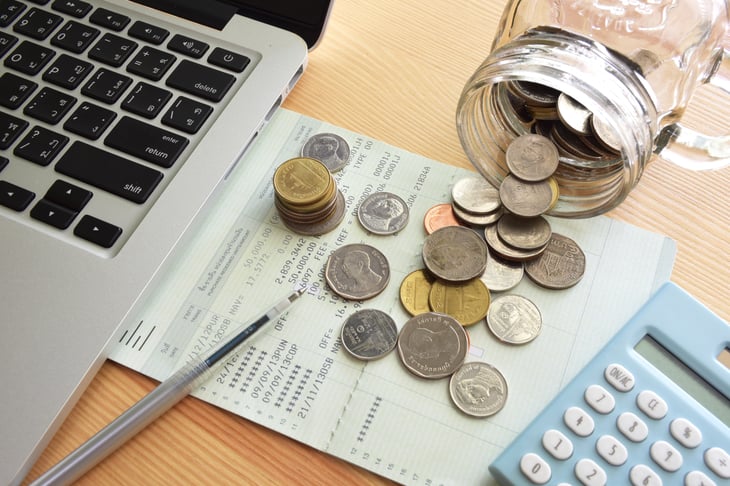
Editor's Note: This story originally appeared on Living on the Cheap.
Saving money for your next vacation is a great goal, but it’s often easier said than done. If you’re like the rest of us, most of your money is spoken for before you even get it.
To save up enough money to go on a trip, you need to start planning in advance. You’ll want to add a vacation category to your household budget and sock away money for travel purposes throughout the year. But where are you going to find the money to put in your vacation jar?
First, you need to figure out how much you need to save for a vacation. Once you have a number in mind, we’ve got tips for how to save up for a vacation down the road, as well as how to save money fast for a vacation that you’ve already booked and is rapidly approaching.
How much should I save for vacation?

How much you should save for vacation depends on the length and type of vacation you want. We’ve seen reports that the average vacation for one person costs $1,145, but that number can vary widely.
A long weekend camping trip, where you bring all your food from home, will cost far less than a weeklong stay at a resort in the Caribbean. If you’re splitting a vacation home with friends, you’ll need to save less than if you were renting the same property just for your immediate family.
The best thing to do is to decide what type of trip you want to take and make a list of all the expenses: transportation, lodging, meals, activities, souvenirs.
Do a little research to figure out the average costs, add them up, and figure out how much you need to save per month to pay for your travel. Here are summer vacation ideas for budgets of $500, $1,000 and $5,000.
In normal times, a domestic U.S. flight costs on average around $350. The average cost of a hotel room is $200. The average cost of travel meals per person, per day, is roughly $35.
However, some destinations are more expensive than others, and your numbers will vary depending on whether you choose a cheap motel or upscale hotel, or a fast-food lunch versus a sit-down fine-dining experience.
How to save money for a future vacation

The way you save money for a vacation is to cut costs in other areas of your life and put your savings into a vacation fund.
It can be as simple as keeping all your change in a jar that you put toward travel or as life-changing as drastically reducing your daily spending and putting the difference into a savings account.
None of these ideas alone will save you a ton of money for travel, but if you practice them regularly, you’ll be surprised at how fast your vacation savings grow.
Slash your grocery budget

According to the USDA, a family of four in the U.S. spends anywhere from $675 to $1,350 per month on food. If you could shave even $100 off your grocery budget each month, that’s $1,200 you could put toward a vacation each year.
You can find plenty of hacks to cut your grocery bill. Use coupons, buy store brands instead of name brands and buy only in-season or on-sale items.
Buy natural ingredients instead of processed foods, dried beans instead of cans, blocks of cheese instead of shredded. Use shopping apps to save money at the store.
Comparison shopping will also help you reduce your supermarket spending, so you can save for your vacation. Switch from an upscale supermarket, such as Whole Foods or Wegmans, to a discount store, such as Aldi or Lidl.
Instead of always going to the same supermarket, read the circulars that come each week and figure out which supermarket in your area has the best prices on the food you need this week.
Eat cheap

If you eat dinner out several nights a week, replace one meal a week with a “cheap meal” at home. The average dinner for four at a fast-casual restaurant is $60 to $80, depending on where you live and what you order. Skip one meal a week, and you could be saving as much as $4,000 a year for your annual summer trip.
Cheap dinners at home don’t have to be boring or stressful to prepare. Soup and sandwiches provide a cheap fill-‘er-up that can be put together quickly, but breakfast foods — think omelets — work well for dinner, too.
Here are some great ideas to shop for groceries on a $4 per day budget.
When you do go out for dinner, ask about discounts. Seniors can save about 10% on meals at many locations, and some restaurants let kids eat free on certain days of the week. You might even get free food on your anniversary.
Plan your meals out around restaurant deals to save even more for your vacation.
Spend less on dress

Americans are obsessed with buying new clothing, whether they want to be trendy or just love some good retail therapy. The average family spends $1,800 per year on apparel, according to the Bureau of Labor Statistics.
If you can cut expenses by a half, or even a quarter, you can save $450 to $900 to put toward a future vacation.
It’s easy to save money when shopping for clothes. Vow to only buy items on sale, and only purchase clothing that you need, not clothing that would be fun to have.
Shop discount stores or thrift stores for cheap buys. If you’ve got growing children, don’t buy brand-new shirts and pants that they’ll wear for a year tops.
Look for used clothes at consignment shops and sales, on neighborhood groups, or “buy nothing” sites.
Stop ordering pricey beverages

You may not realize how much you spend each month on beverages at restaurants and cafe. Starbucks in the morning, a soda at lunch, and even juice and milk for the kids at dinner can really add up.
Switching to water (or home-brewed coffee and tea) will not only help your bottom line, it’ll help your waistline as well.
It’s surprising how easy it is to forego the other beverages. You will soon find that water is the only thing that really quenches your thirst.
Plus, if you need to liven your drink up a bit, squeeze a little lemon or lime into your glass rather than reaching for a soda. If you ate out once every day for a year and drank water instead of a $4 glass of soda or cup of coffee, you would save a whopping $1,460 to apply toward that vacation.
However, don’t switch from soda to bottled water, or you’ll eat up those savings in a heartbeat. If you need water on the go, fill a reusable water bottle with tap water.
You probably have several bottles lying around at home, so you don’t have to buy anything new. If you don’t, you can easily pick up one from your local Buy Nothing group.
Worried about “stuff” in the tap water? Invest in a water bottle with a filter. Compared with the cost of the ready-to-drink bottled stuff, it will pay for itself in no time.
Let’s assume that a plastic bottle of water costs $2, and you drink two per day. Subtract the cost of a nice reusable bottle with a filter, and you will save $1,400 by the end of the year.
Lower your utility bills

Admit it — you’re not as rigorous as you should be about reducing your heat and air-conditioning use, or turning off lights when you leave a room. But following energy-saving best practices and investing in energy-efficient appliances could shave hundreds off your energy bill each year and pad your vacation fund.
The Department of Energy estimates you can save $730 to $1,200 annually by making changes, such as improving your storm windows, installing a low-flow toilet and switching to energy-efficient light bulbs.
Without buying anything, you can lower your energy bill right away by adjusting your thermostat by a degree or two and making sure you lower it when you’ve left the house and while you’re sleeping.
Keep warm in the winter with blankets, sweaters, and fuzzy socks rather than your electric heat. You can save even more on utility bills by repairing leaks and maintaining your air ducts, heating system, and appliances.
If you use all five of these tips, you could possibly save $10,000 toward a fantastic vacation.
How can I save money for an upcoming vacation fast?

What if you don’t have time for a slow-and-steady savings strategy, like the one we’ve discussed here? If you’ve got your heart set on taking a vacation soon, say in six months, you’ll need to make more drastic and larger-scale spending cuts.
We do not recommend that you go into debt or skip important payments to take a vacation.
Here are some strategies you can take to save money fast for that vacation.
Cut out entertainment expenses

This advice might not be sustainable advice for the long term, but if you really need to pay for that booked vacation, try cutting out all your entertainment expenses — such as dining out, movies, sports games, etc. — for a limited time.
Put that money into your vacation fund.
After your trip, you can reassess whether you want to cut the cable cord entirely or if you can reduce, but not eliminate, the amount you eat out or go to movies, so you can save for your next travel adventure.
Cancel or freeze subscriptions

To save money for vacation fast, cancel or freeze your subscriptions, such as online newspapers or streaming services, that aren’t essential.
You might find that you weren’t reading the New York Times or Sports Illustrated enough to warrant the monthly fee anyway.
It also might be the incentive you need to look into a cheaper gym if you’re not working out as often as you wish you would.
Plan a no-spend month

What’s a no-spend month? It’s a month in which you purchase only absolute necessities and try to eat as much you can from the pantry and freezer staples you’ve already purchased.
It’s a great way to take a look at where your money is going and curb impulse buys. It sounds challenging, but you can do anything for just 30 days.
Renegotiate

If you can, renegotiate rates for internet, cellphone, and cable TV services, or other utilities where you might have a choice in providers or plans.
Are there competing trash companies in your area? See if the competition is cheaper than the service you use.
Calling your cable or cellphone service provider and threatening to cancel is often a surefire way to get offered a lower rate. Use the money you save to pay for your vacation.
Only by being serious about saving will you be able to sock away enough money to enjoy your rapidly approaching vacation.
And don’t forget to look into ways to save during your trip. Once you’re back, consider following a more long-term budget plan that allows you to save for annual getaways.





Add a Comment
Our Policy: We welcome relevant and respectful comments in order to foster healthy and informative discussions. All other comments may be removed. Comments with links are automatically held for moderation.